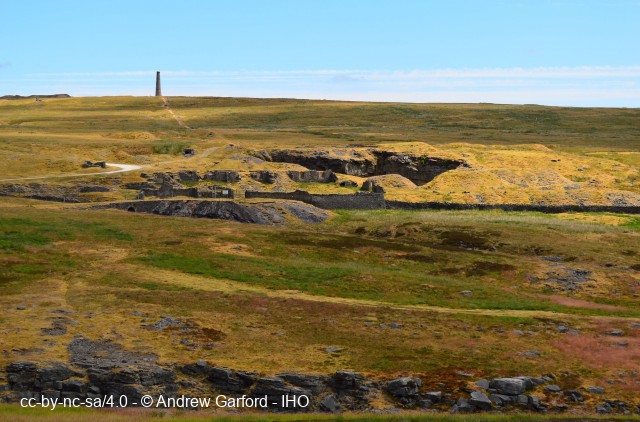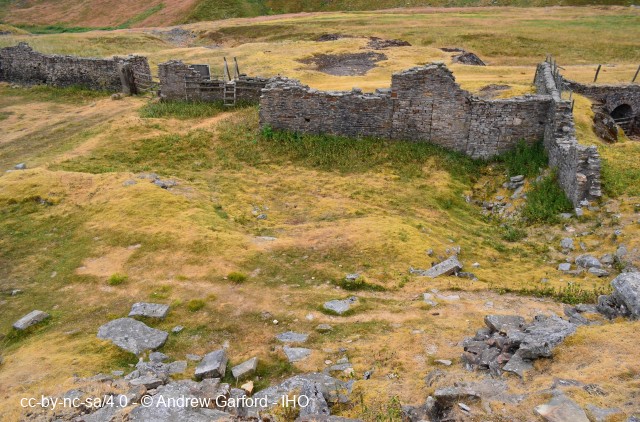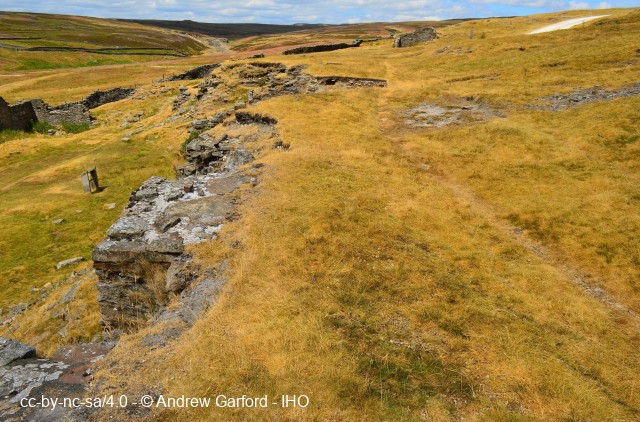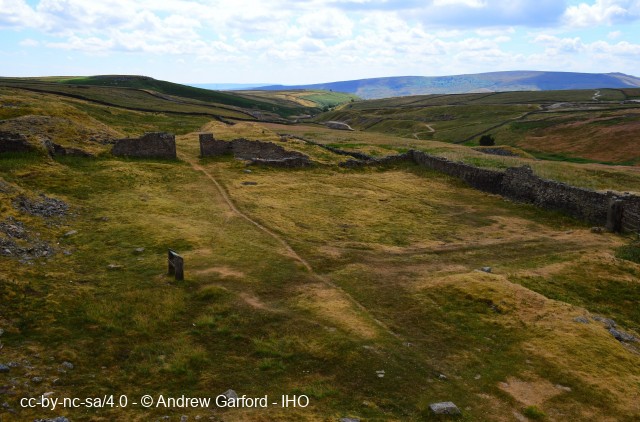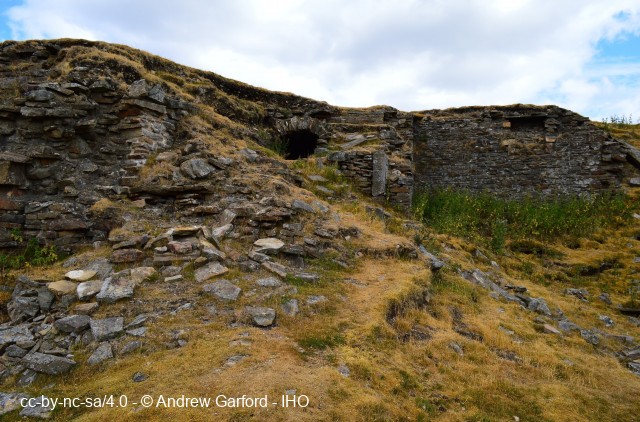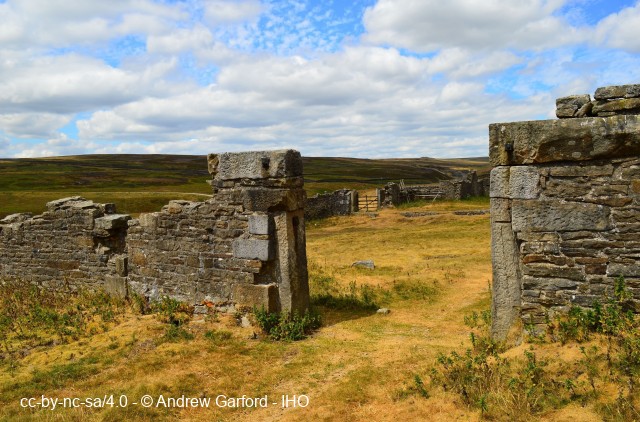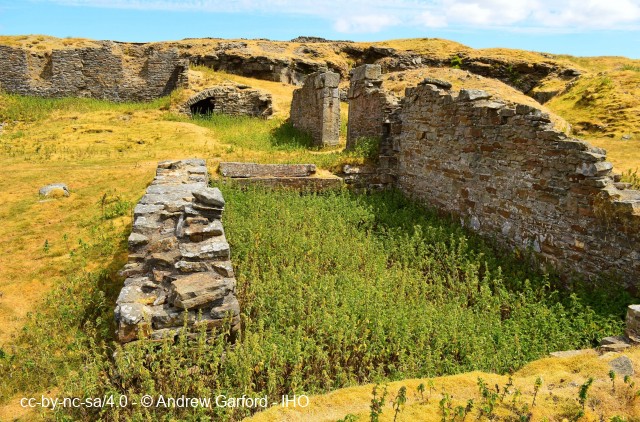Description and History of Site:-
The remains of a large Cupola (reverberatory hearth) lead smelting mill, owned by the Duke of Devonshire, who held the mineral rights to Grassington Moor.
The mill having been enlarged from a previous mill on site was provided with multiple Cupola hearths to smelt all the lead ore mined on the moor, along with a slag hearth and a roasting hearth, used for improving the quality of lead produced and the percentage of lead extracted from the dressed ore.
A reverberatory, or cupola, hearth differed from the traditional ore hearth favoured by the smaller mills, by keeping the ore separate from the fire, reflecting the heat onto the ore, thereby causing the lead ore to flow separately from the fire.
An ore hearth has the lead ore placed directly on top of the heat source, usually a mix of wood and peat, the lead then flowing through the fire onto a hearth to be collected into a heated sumpter pot. It was ideal for the smaller parcels of lead from the smaller mines.
The reverberatory hearth, which burned coal, sometimes mixed with peat, was only used by the larger mine organisations who could keep it fed with a constant flow of ore, and was able to produce a greater quantity of pig lead.
The coal was mined locally at Threshfield and Thorpe Fell pits for the Cupola Mill.
The hearths at this smelt mill were covered by a lean-to roof, with the smelters wearing knitted shawls, to protect their heads necks and shoulders from the strong draughts at their backs caused by the hearths. Many of the miners knitted their own items of clothing such as long thick stockings and shawls, a popular pastime amongst the men often knitting whilst walking from the mines and home.
Still visible today (2018), to the rear of the mill is an extensive network of flues and Stokoe type condensers which ran for a total of 5140' (1.5km) over the moor to a 60' (18.2m) high chimney. Valuable lead was washed out of the flues and condensers, by young boys able to fit into the confined spaces, into settling tanks and then re-smelted. This way 4-6% of the total lead smelted could be recovered.
The remains of the site still visible (2018) are the surrounding compound wall, ore chutes, lead store, and store house with arched entrance.
Robert T Clough surveyed the mill in 1947 and published the site plan in his book 'The Lead Smelting Mills of the Yorkshire Dales and Northern Pennines', thereby allowing the layout of the mill remains today (2018) to be interpreted. The Coalgrovebeck Company built the Moor Mill smelting mill, and started smelting October 1756.
The Duke of Devonshire bought it in 1758. Cupola Mill was built alongside and the two mills incorporated together taking advantage of Moor Mills existing 22' (6.7m) waterwheel. Cupola's Slag Hearth was probably the former Moor Mills Ore Hearth.
Two Reverberatory Hearths were installed, a third added in 1825 (M.C. Gill) and smelting commenced October 1792.
The flue system was only a short 60' (18.2m) at that time with the chimney directly behind the mill, however it proved to be insufficient so between 1840-1855 the present flue system and chimney were built.
Mining finished on Grassington Moor about 1882, but there was enough ore held at the mill, to continue smelting for another twelve months.
In 1885 there was still 60 tons of pig lead stacked in the yard, the result of a large parcel of ore from the Buckden Mining Company, this being the last ore to be smelted at this mill. (see NYK01669)
Further Reading and References:-The Lead Smelting Mills of the Yorkshire Dales and Northern Pennines, Clough, R.T. pp76-80
Lead Mining in the Mid Pennines, Bradford Barton Ltd. Raistrick, A. p110
NMRS British Mining Number 48, Gill, M.C. p142
Mines and t'Miners, Dickinson, J.M. pp17-19
http://www.nmrs.org.uk/assets/pdf/BM48/BM48-132-151-smelting.pdf
Life and Work of the Northern Lead Miner, Raistrick, A & Roberts, A, Alan Sutton-Beamish. P71
Men of Lead - Miners of the Yorkshire Dales, Galena Books, Joy, David. pp 25-26, 58
Falconer K, Guide to England's Industrial Heritage, Batsford, 1980
Help us improve this entry
The compilers welcome corrections or additional information on all sites.
Any information provided will be verified before appearing on the web site.
Email comments
Key Words :- lead smelt mill reverberatory hearth cupola
Viewing the Site :- Public footpath onto site.
Address :- Grassington, North Yorkshire
Grid Ref :- SE 02491 66303
Co-ordinates :- Lat 54.092625 , Long -1.963408
Local Authority :- Craven District Council
Pre 1974 County :- Yorkshire - North Riding
Site Status :- Scheduled Ancient Monument SAM
Historic England List No - 1018333,
Site Condition :- Site derelict - some buildings remaining
Site Dates :- 1792 - 1885
Record Date :- 16 July 2018
Copyright :- cc-by-nc-sa 4.0 © Andrew Garford
Grid Ref :- SE 02491 66303
Co-ordinates :- Lat 54.092625 , Long -1.963408
Local Authority :- Craven District Council
Pre 1974 County :- Yorkshire - North Riding
Site Status :- Scheduled Ancient Monument SAM
Historic England List No - 1018333,
Site Condition :- Site derelict - some buildings remaining
Site Dates :- 1792 - 1885
Record Date :- 16 July 2018
Copyright :- cc-by-nc-sa 4.0 © Andrew Garford
